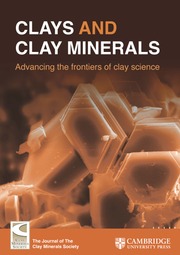Article contents
An Experimental Study of Cadmium Ion Exchangeability
Published online by Cambridge University Press: 01 July 2024
Abstract
A laboratory study of cadmium exchangeability revealed large differences in extractable cadmium which are dependent on the exchange solution being utilized. The standard exchange solutions employed in this study were: N NaNO3, N NaOAc, N NH4OAc, NCaCl2, and 2N CaCl2, in order of increasing Cd removal. An interpretation of the chemical behavior of Cd and an experiment with mixed sodium nitrate and acetate solutions suggest that cadmium carbonate, octavite, was precipitated when the sediments were saturated with Cd prior to the exchange experiments and that the quantities of Cd recovered in the acetate solutions were erroneously high because of the dissolution of the carbonate material. Dissolution of solid phases, the lack of pH buffering, and the possible formation of a complex hydroxyl chloride salt also made the Cd values obtained with the chloride solutions too high. Sodium nitrate exchange solutions minimize these problems and are thought to best represent the exchangeable cadmium in the sediment.
Резюме
Лабораторное изучение обменной способности кадмия обнаружило большие различия в экстрагируемых количествах кадмия,что зависит от раствора, применяемого при обмене.Стандартными обменными растворами,которые использовались при этих исследованиях,были: N,NaNO3, NaOAc,H-NH4OAc, N.СаСl2, и 2N. СаCl2, чтобы увеличить отщепление кадмия.Интерпретация химического поведения Cd и опыт со смешанными растворами азотно-натривой соли и ацетата показали, что карбонат кадмия,октавит,осаждался,в то время как отложения были насыщены кадмием еще до экспериментов обмена и что количество Cd,обнаруженное в ацетатном растворе,было завышено в результате растворения карбонатного материала. Растворение твердых фаз,недостаточное буферное действие pH и возможное образование гидроксильной хлоридной соли также вызывают слишком высокое извлечение Cd,Обменные растворы азотно-натриевой соли сводят к минимуму эти проблемы и,предполагается,правильно определяют обменное количество кадмия в отложениях.
Information
- Type
- Research Article
- Information
- Copyright
- Copyright © 1978, The Clay Minerals Society
Footnotes
This work is a result of research sponsored by NOAA Office of Sea Grant, Department of Commerce, under Grant No. 2-35231. The U.S. Government is authorized to produce and distribute reprints for governmental purposes notwithstanding any copyright notation that may appear hereon.
References
- 6
- Cited by

